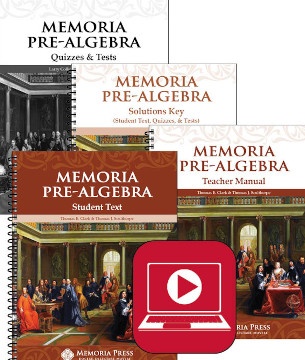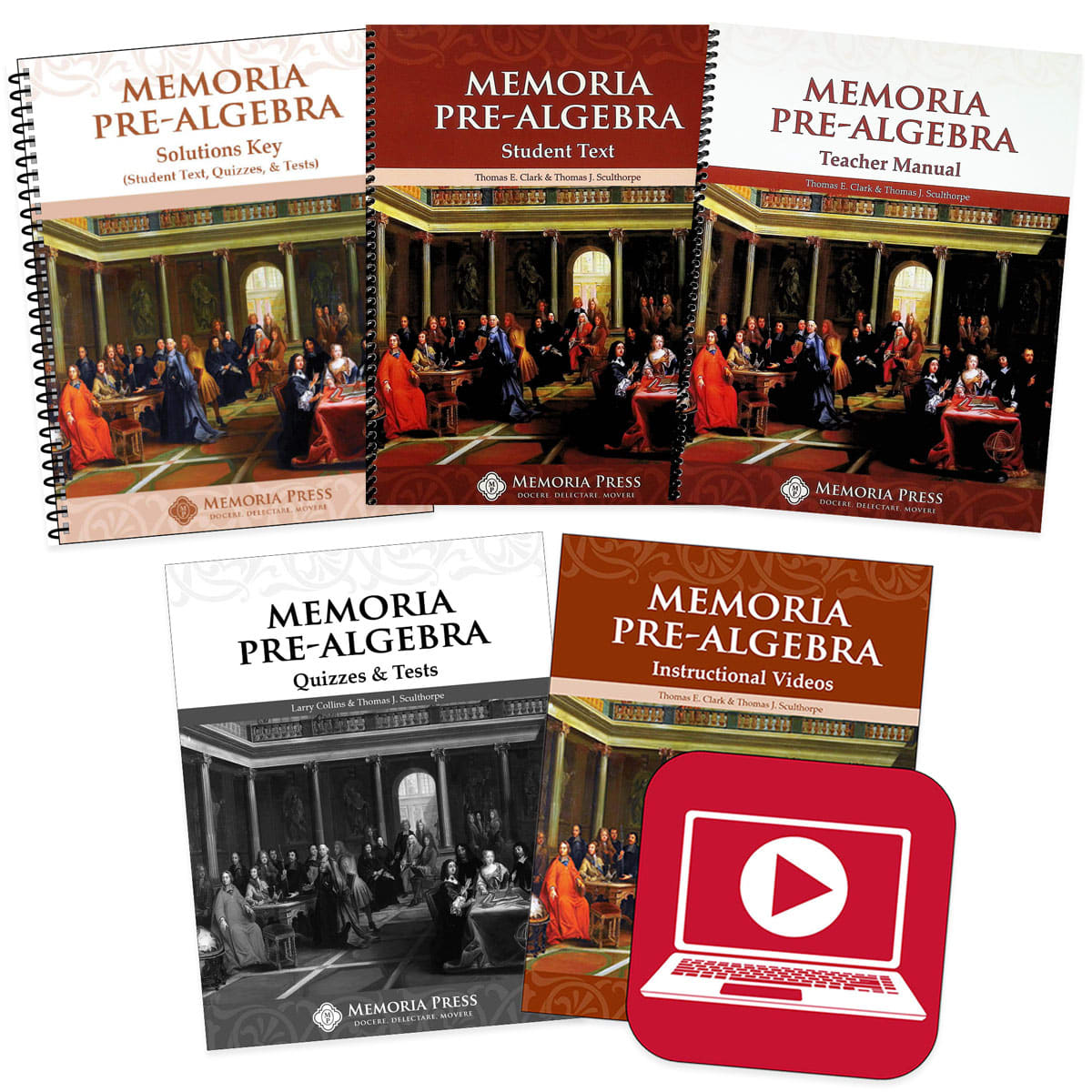Memoria Pre-Algebra lays a foundation for high school math with solid and thorough instruction on concepts such as the language and symbols of math, mathematical operations, the order of operations, equations, equalities and inequalities, positive and negative numbers, sets, functions, first-degree relations with one variable, exponents, absolute value, and an introduction to the Cartesian coordinate system. One topic missing that is often taught in pre-algebra is square (and other) roots, but those are dealt with extensively in Memoria' s Algebra 1.
The course teaches conceptual understanding, often presenting more than one way to approach a problem. Students need to apply themselves, thinking through the concepts and example problems to grasp the many new concepts they will be learning.
Before starting this course, students need a solid grasp of the four mathematical operations, plus an understanding of fractions, decimals, and percents. The Teacher Manual includes a 30-question readiness exam that can be used to ensure students have the foundation to begin this course. Coming from most other math programs, Memoria Pre-Algebra would be used in seventh grade, allowing students to begin Algebra I in eighth grade. (Memoria Algebra I is under development.)
Course components are Student Text, Teacher Manual, Solutions Key, Quizzes & Tests book, and online videos. (The Student Text, Teacher Manual, and Solutions Key have spiral bindings so they can lie flat when opened.) In addition, when you order the course, you receive links to download an eight-page file with lesson plans, a one-page file showing the lengths of the videos for each lesson, and a PDF of the Quizzes & Tests book so you can print as many copies as you need.
How It Works
The course begins with an introduction to mathematical language and symbols. The progression of concepts is well thought out, most of the time building logically upon previous lessons. Most lessons in the first two units focus on mathematical operations, symbols, and the abstract methods we use to write and solve mathematical expressions and problems. Within those lessons, students are sometimes asked to “translate” mathematical expressions into words, in essence learning to both read and understand the language of mathematics. Much of this is learned in the context of problems involving fractions, decimals, and percents, an excellent reinforcement and development of what students should have learned up through sixth grade.
Lessons 46 through 50 at the end of the second unit focus on complex word problems, helping students see how their learning applies in real life. In the last six lessons, which are on the Cartesian coordinate system, students also apply algebraic concepts as they learn to do operations such as finding solution sets for inequalities and graphing them on grids and determining the slopes of lines algebraically and then graphing them.
The course’s design should appeal to students who appreciate its progressive scaffolding that continually builds one idea upon another rather than a course that teaches in increments, cycling back to expand on those topics weeks later.
Lessons begin with recitation (described below), then follow the typical lesson presentation of most math courses: instruction, example problems, and independent work on exercises. The course must be taught, although a few lessons will be self-evident enough for students to complete without direct instruction. Rather than teach the course themselves, parents can have students watch video lessons taught by Thomas Sculthorpe, one of the course authors. The videos vary in length from about 5.5 minutes to 33 minutes. with Sculthorpe teaching new concepts and working through example problems. The instructional material included in the Teacher Manual is briefer than Sculthorpe’s presentations and is not scripted. It explains what the parent/teacher needs to convey to students, often encouraging the teacher to take the time needed to ensure students grasp a challenging concept.
Some lessons are relatively easy to understand while others introduce concepts that are challenging and require diligent thought and practice. The teacher needs to make sure students understand concepts before tackling exercise sets. Answers to odd questions from the exercises are at the back of the Student Text, so they can check themselves as they go to some extent. The Solution Key has fully worked out solutions for all problems from exercises, quizzes, and tests.
Exercises vary in the number of problems from two to more than 50 depending upon the complexity of the problems. Students should copy most problems into a notebook since the Student Textbook doesn’t usually provide space for working out problems. (Students need not copy entire word problems but should show their work.) Working on graph paper is an excellent idea since it helps students arrange problems properly and provides grids on which to draw number lines and Cartesian grids when required.
The lesson plans are extremely helpful since there are 56 lessons that take one or more sessions to complete, and it’s not obvious without lesson plans how much time to plan for each. The lesson plans also build in frequent review sessions, usually by having students solve problems they have already completed in recent lessons. The “Teaching Guidelines” in the Lesson Plans tell teachers to assign review problems one at a time and check them immediately to ensure students have grasped the concepts and skills. Review questions might also be taken from Form B of the quizzes and tests.
Daily lessons should begin with practice of the week’s recitation questions and answers that help students master key terms and concepts. For example, the first recitation question is “Define number symbols,” and the answer is, “More commonly called numerals, symbols used to represent quantities.”
The recitation questions and answers are included in the lessons themselves, and charts with all 108 questions and answers are at the back of both student and teacher books. The charts show the recitation questions for each lesson, making it easy to find and review them. The number of recitation questions per lesson varies from none to nine. (Those for the lesson with nine recitation questions include simple ones like the definitions of a set, a finite set, and a null set, so they are not tough to learn.) The “Teaching Guidelines” recommend reviewing recitation questions learned in prior weeks.
The course is presented in three units, with the third unit significantly shorter than the other two. Each of the first two units has five parts with a quiz for each part. Each of the three units has a test. Every quiz and test has both a Form A and a Form B that can be used for retaking them or as review assignments. An introductory page at the beginning of each unit and most sections explains the overarching goals and supplies some interesting information on the history of mathematics and famous mathematicians.
The logical design, the inclusion of conceptual thinking, and the memorization of the recitation questions all make this course particularly appealing to those pursuing a classical form of education, but it isn’t limited to that audience.
Summary
Memoria Pre-Algebra is very well thought-out in both content and layout. It’s a challenging course, but it should do an excellent job of preparing students for high school math.













